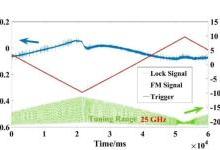原文如下:
A microlaser in the size of a pinprick has been developed that can identify and count individual viruses accurately. It can also be used to count the nanoparticles that initiate cloud formation or pollute the air we breathe.
The inset at the top right shows a particle landing on the microlaserLight from the micro-laser is disturbed when a particle sits on the ring, thus altering the frequency of light. The ring can count nanoparticles of the order of 800 before losing signals in the noise. By stimulating more than one mode, scientists can be doubly sure about the count’s accuracy. And by varying the gain medium, they can use the sensor for water instead of air.
The assistant professor of electrical and systems engineering at Washington University, Lan Yang led a team to create the new sensor, which can be used commercially in fields ranging from aerosol science to biology. Details on the sensor are recorded in Nature Nanotechnology.
The new sensor is different from previous whispering gallery resonators as it is a miniature laser instead of an external laser’s resonating cavity. When a particle comes in contact with the microlaser, two different frequencies with slight variations are generated. The frequency splitting can be measured by combining the split laser modes in a photodetector, which generates a beat frequency that matches the difference in frequency.
The microlaser offers high sensitivity than the passive resonator, Yang says. The maximum resolution achieved by the microlaser is about one nanometer.
When the laser is present in the ring, the whole system is self contained and simple rather than when it is coupled to the ring. The optical medium can be activated using a light source says Yang, and an inexpensive laser diode can be used in the place of an expensive tunable laser. The team tested the performance of the micro-laser using nanoparticles of different sizes and various materials, such as polystyrene, gold, and virions.
Next, the team wants to design the tiny microlaser’s surface to identify DNA and single biological molecules. When DNA is attached to engineered nanoparticles, the micro-laser sensor can count each DNA molecule or even molecule fragments.


